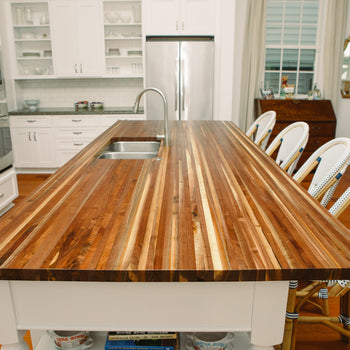It appears that your cart is currently empty

Wood Types
Types of Woods NOLA Boards Uses
NOLA Boards uses only environmentally responsible and renewable woods in making our products. Here is a listing of our most popular types of woods.
Do you have questions about the differences in wood grains?
Visit our Wood Grains page to learn more.
Black Walnut Wood



Prized for its distinctive rich and robust color, black walnut is commonly used in furniture building. It is grown throughout the eastern and central United States.
- Appearance: Light to dark chocolate brown. Often the wood can often has a grey, purple or reddish cast. Creamy yellow sapwood is a common feature as well. Usually has a straight, dense grain, though irregularities are not uncommon.
- Aging Qualities: Becomes grayer and more yellow with age, but only moderately.
- Other Qualities: Strong, hard and durable.
Cherry Wood



Cherry is one of the most highly valued furniture building woods due to its strength, beautiful color, easy workability and the incredibly smooth and glossy finish that it displays when properly sanded. It is grown in the eastern United States, mostly in northern and lake states.
-
Appearance: Light pink to reddish brown with straight, uniform, fine grain.
-
Aging Qualities: Darkens significantly with age.
-
Other Qualities: Highly shock resistant.
Maple Wood



Maple is valued by furniture builders for its workability, consistency, hardness, and easy to paint surface. It is grown in all over the United States, but primarily throughout the eastern states.
- Appearance: Almost white to light grey with a faint yellow hue. Sometimes features grey, fine, uniform grain.
- Aging Qualities: Darkens a little with age.
- Other Qualities: Medium shock resistance.
Sapele Wood



Sapele is a beautiful hardwood that is often compared to (and even marketed as) mahogany due to its rich reddish brown color and denseness. It is grown in tropical regions of west Africa.
-
Appearance: Textured reddish brown grain with golden hues. Interlocked grain with a fine uniform texture and a nice natural luster.
-
Aging Qualities: Color will darken with age.
-
Other Qualities: Very dense and rot resistant.
Sinker Cypress Wood (Please note we are no longer using Sinker Cypress in countertop projects at this time. These pictures are for reference only for custom cutting board projects.)



Cypress trees are iconic in Louisiana, and are incredibly valuable to furniture and home builders due to their remarkable durability and rot resistance. The “sinker” in “sinker cypress” refers to how these logs were pulled from the bottom of a river.
In the late 1800’s through the early 1900’s, when the preferred method of transporting wood to locations downriver from where they were harvested was by lashing the logs together in a crude raft, it was not uncommon for these rafts to break apart and for some logs to sink to the bottom of the river. The cypress logs would lay there for up to a century!
The outer layers of the wood slowly decomposed, but the lack of sunlight and oxygen perfectly preserved the dense, oily heartwood. Sinker cypress is always found in the rivers and bayous of the southern and coastal United States.
-
Appearance: Varies due to the different minerals the wood is exposed to depending on where it has been submerged in water. Usually the wood displays a rich, glossy yellow and greenish hue.
-
Aging Qualities: Darkens to a rich, yellowish brown with age.
-
Other Qualities: Extremely durable and rot resistant. Oily, almost waxy feel to the wood.
White Oak


The most widely used hardwood in the United States, white oak is grown primarily in the eastern United States.
-
Appearance: Creamy white to medium brown heart and sapwood. The heartwood often exhibits an olive colored cast. Has an exceptionally straight and uniform grain.
-
Aging Qualities: Does not darken much with age.
-
Other Qualities: Nearly impervious to liquids and highly rot resistant, white oak has been extensively used for ship timbers, barrels and casks.
